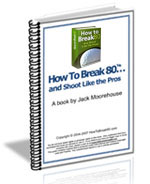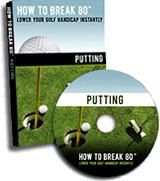|
Avoiding the "Line of Charm"
By Jack Moorehouse
Golf is as much mental as physical. You have to execute both phases to achieve a low golf handicap. Just ask any player who's ever stood over a short clutch putt. She may have made this put a thousand times before. But on the day she's asked to hole that putt for the club championship, the cup looks about as big as a pinhole, even from a foot away. The thought of missing the putt plays havoc with the golfer's mind, as I've mentioned in my golf tips, and causes some people to miss the putt.
When an architect creates a truly challenging hole, he creates the same kind of stress in the player's mind as the short putt does in the example above. The golfer starts thinking about the "bad" things that could happen, instead of concentrating on the putt. With the process of execution disturbed, the chances of success decline. The one thing the player must do on a challenging hole is carefully weigh the risk/reward factors before accepting the architect's challenge.
The Line of Charm
Course architects, as I tell students in golf lessons, often use psychological ploys to challenge and excite a player's interest. These ploys can be traps. One of the most basic is the "line of charm," a term coined by designer and writer Max Behr. He designed golf courses in the 1920s and also wrote on the subject.
The line of charm is a tantalizing path to the green that attracts the golfer's eye but is fraught with danger and disaster. The line of charm challenges the line of play that the architect has outlined. It almost always lies close to several hazards. And it draws the golfer in but threatens to undo him, if he's not careful. When faced with this situation, you must always look at the risk/reward equation, as I tell players in golf instruction sessions.
Take the 16th hole at Cypress Point Golf Club. The hole represents a great golf challenge for any player. It stretches out onto a rocky promontory in the Pacific Ocean. The course's architect, Alister Mackenzie, used the Pacific as one of the most dramatic hazards in golf. Mackenzie also stretches the limits of this par 3 hole by lengthening it to 235 yards.
Mackenzie uses the line of charm to lure golfers away from the safer layup and pitch route that ensures no worse than a bogey 4 and toward the more difficult shot over the ocean. This shot leads to a birdie or par—if executed properly. But miss it and you'll most likely end up with a double bogy or worse. Regardless of how you do on the hole, you'll remember the experience, thanks to the psychological affects the architect built into the course.
Playing Tricks
Architects also play tricks on golfers. The penal value of the hazard and the fear and excitement it arouses, don't always match up. Often, the psychological factors introduced by the hazard outweigh the physical danger. A large greenside bunker may cause players to hit away from it only to bring deep rough or a combination of other hazards into play. This is similar to the out-of-character shot created by a seemingly easy hazard. How many times have you seen a player who normally blasts good drives skip one into a small lake in front of the tee box.
Water is the most fearsome of hazards but the architect will use anything at his or her disposal. Take George Crump, who built Pine Valley Golf Club in the sandhills of western New Jersey. With limited water available, he used carries over sandy waste areas to duplicate water's psychological effect. In other words, he used sand to mimic water. And he did it effectively.
Psychological ploys, like the line of charm, tempt golfers away from the "righteous" path. The golfer's ultimate goal is to assess all the hazards on the hole, not just the dramatic ones, before deciding on the shot. Smart golfers process the risk and lay up when necessary. But you must keep your wits about you and avoid the temptations the architect places before you. And you must focus on the success of the shot, not the dangers.
The architect's job is to challenge the golfer and create fear and excitement on the hole. By understanding what the architect is trying to do and focusing on executing the shot, not what could happen if he misses, the golfer avoids succumbing to the temptation of psychological tricks, like the line of charm. To knock down your golf handicap and achieve lower scores, you need to carefully weigh the risk/reward factors on each hole before deciding on your path.
Jack
Moorehouse is the author of the best-selling book "How
To Break 80 And Shoot Like The Pros." He is NOT a golf pro, rather a
working man that has helped thousands of golfers from all seven continents lower
their handicap immediately. He has a free weekly newsletter with the latest
golf tips, golf lessons and
golf instruction.
|
Tools To
Help Your Game!

eBook

Physical Book

Audio Program

Short Game DVD

Driver DVD

Putting DVD
|